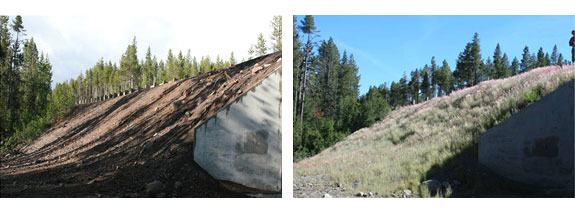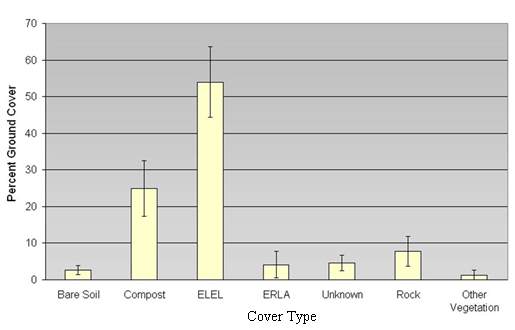ROADSIDE REVEGETATION
An Integrated Approach to Establishing Native Plants and Pollinator Habitat
Learn
Compost Blanket Installation
| Location: | Crescent Lake Snowmobile Underpass - 0.5 north of Crescent Lake Junction on Highway 58 |
| Lat/Long: | N43o32'14.82", W121o56'50.28" |
| Dates Implemented: | May 2006 |
| Client: | Western Federal Lands Highway Division |
| Planners: | R6 Restoration Services Team |
| Contractors: | Wildlands Inc. |
| Case Number: | 0002 |
| Date Submitted: | December 2008 |
| Focus Area: | Compost, Seeds |
Background and Objectives
The two acre project is a 1V:2H fill slope constructed to allow snow mobile crossing beneath Highway 58. This is a high recreational use area in National Forest Lands. Project objectives called for vegetated slopes of native species that would be visually appealing, control erosion, and reduce the potential for weed invasion. The desired future condition, or success criteria, to be monitored two years after implementation were: 1) reduce erosion by limiting bare soil exposure to less than 25% of the ground surface and 2) return native vegetation by establishing a minimum surface cover of 35 percent composed of perennial, native grasses and forbs.
Implementation
The major limitations to reestablishing native vegetation were soil related - compacted volcanic ash subsoils with low fertility and a gravelly, sandy loam texture, with low water holding capacity. The revegetation specialist was called in near the completion of the road construction project which narrowed the treatments that were available. Applying compost to the soil surface as a compost blanket was the selected treatment because of high nutrient levels and high water holding capacity of the material. Compost was purchased from Sunriver Water Environmental LLC in Sunriver OR and originated from wood fiber and municipal waste material passing a 3 inch sieve. Compost was pneumatically applied to a depth of 2 inches. Prior to installation, hay bales containing seeds of squirreltail (Elymus elymoides) seeds1 were applied evenly across the site. Seeds of woolly sunflower (Eriophyllum lanatum) were sown with a hand seeder. Both species originated from locally collected sources.
Findings
Second year monitoring using the linear sampling design (see Chapter 12 of the Roadside Revegetation Technical Guide) and the Cover Monitoring Assistant (CMA) program indicated that project objectives were achieved. Bare soil averaged less than 5 percent, well under the 25% threshold. Native vegetation exceeded 50% and was primarily composed of the two species that were seeded. The presence of weeds was minimal.
Figures
The photograph on the left was taken in spring 2006 prior to the application of compost. The photo on the right was taken 14 months later in Summer 2007, one year after installation. The major species is squirreltail.

This graph summarizes the monitoring data collected two years after seeding. Squirreltail (ELEL) had the greatest ground cover followed by compost cover. The woolly sunflower (ERLA) covered much less of the surface but this species visually dominates the site when in bloom. The bars represent the confidence intervals for each cover type.

Applicability
The use of compost as a surface cover has been shown to be effective in establishing grass and forb species throughout the western US. Not only does it provide a growing medium for these species, it also protects the soil from surface erosional forces.
Squirreltail and woolly sunflower have been used successfully in restoration projects in central Oregon. Woolly sunflower is a very spectacular, showy species when in bloom in late June through July. Even at 5% of the surface cover, the flowers dominate the site when in bloom. Squirreltail forms very good ground cover, especially on deeper soils.
Related Links
Technical Guide,
Table 10.9 General specification ranges for composted materials
for manufactured topsoil
Crescent
Lake Snowmobile Overpass Project (2.29
MB PDF)
Contact Information
Scott Riley, Umatilla National Forest, 541-969-7683, sriley@fs.fed.us
1Since squirreltail seeds are difficult to harvest and clean commercially, seed growers have an option to bale the seeds in with the hay bales, eliminating the combining and cleaning processes).